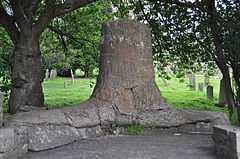Sigillaria
| Sigillaria Temporal range: Carboniferous to Permian | |
|---|---|
 | |
| Sigillaria tree (Stigmaria) from Stanhope, County Durham, UK | |
| Scientific classification | |
| Kingdom: | Plantae |
| Division: | Lycopodiophyta |
| Class: | Isoetopsida |
| Order: | Lepidodendrales |
| Family: | Lepidodendraceae |
| Genus: | Sigillaria |
Sigillaria is a genus of extinct, spore-bearing, arborescent (tree-like) plants which flourished in the Late Carboniferous period but dwindled to extinction in the early Permian period. It was a lycopodiophyte, and is related to the lycopsids, or club-mosses, but even more closely to quillworts, as was its associate Lepidodendron. Sigillaria was a tree-like plant, with a tall, occasionally forked trunk that lacked wood. Support came from a layer of closely packed leaf bases just below the surface of the trunk, while the center was filled with pith. The old leaf bases expanded as the trunk grew in width, and left a diamond-shaped pattern, which is evident in fossils. The trunk had photosynthetic tissue on the surface, meaning that it was probably green.
The trunk was topped with a plume of long, grass-like, microphyllous leaves, so that the plant looked somewhat like a tall, forked bottle brush. The plant bore its spores (not seeds) in cone-like structures attached to the stem. Sigillaria, like many ancient lycopods, had a relatively short life cycle - growing rapidly and reaching maturity in a few years.
Some have suggested that Sigillaria was monocarpic, meaning that it died after reproduction, though this is not proven. It was associated with Lepidodendron, the scale tree, in the Carboniferous coal swamps.
Gallery
-

Sigillaria on display at State Museum of Pennsylvania, from Sharon, Mercer County, Pennsylvania
-

Sigillaria (bark) on display at State Museum of Pennsylvania, from Scranton, Lackawanna County, Pennsylvania
-
Replica of Sigillaria sp. in a laboratory of practices of the Faculty of Sciences of the University of A Coruña
-
In situ Lycopsid that is probably Sigillaria from the Pennsylvanian Joggins Formation in Nova Scotia
External links
| Wikimedia Commons has media related to Sigillaria. |

